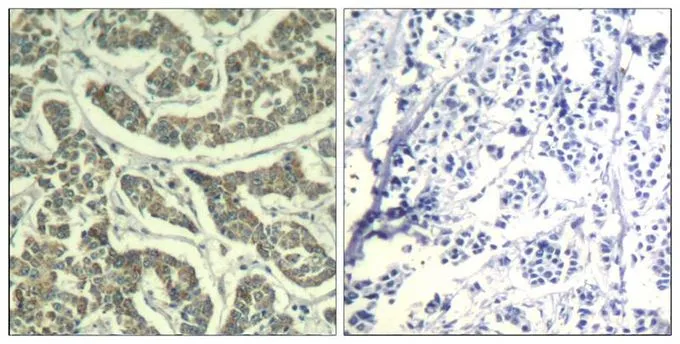ATR (phospho Thr1989) antibody
GTX128145
ApplicationsImmunoFluorescence, ImmunoPrecipitation, Western Blot, ImmunoCytoChemistry, ImmunoHistoChemistry, ImmunoHistoChemistry Paraffin
Product group Antibodies
TargetATR
Overview
- SupplierGeneTex
- Product NameATR (phospho Thr1989) antibody
- Delivery Days Customer9
- Application Supplier NoteWB: 1:500-1:3000. ICC/IF: 1:100-1:1000. IHC-P: 1:100-1:1000. IP: 1:100-1:500. *Optimal dilutions/concentrations should be determined by the researcher.Not tested in other applications.
- ApplicationsImmunoFluorescence, ImmunoPrecipitation, Western Blot, ImmunoCytoChemistry, ImmunoHistoChemistry, ImmunoHistoChemistry Paraffin
- CertificationResearch Use Only
- ClonalityPolyclonal
- Concentration0.09 mg/ml
- ConjugateUnconjugated
- Gene ID545
- Target nameATR
- Target descriptionATR checkpoint kinase
- Target synonymsFCTCS, FRP1, MEC1, SCKL, SCKL1, serine/threonine-protein kinase ATR, ATR serine/threonine kinase, FRAP-related protein-1, MEC1, mitosis entry checkpoint 1, homolog, ataxia telangiectasia and Rad3-related protein
- HostRabbit
- IsotypeIgG
- Protein IDQ13535
- Protein NameSerine/threonine-protein kinase ATR
- Scientific DescriptionThe protein encoded by this gene belongs the PI3/PI4-kinase family, and is most closely related to ATM, a protein kinase encoded by the gene mutated in ataxia telangiectasia. This protein and ATM share similarity with Schizosaccharomyces pombe rad3, a cell cycle checkpoint gene required for cell cycle arrest and DNA damage repair in response to DNA damage. This kinase has been shown to phosphorylate checkpoint kinase CHK1, checkpoint proteins RAD17, and RAD9, as well as tumor suppressor protein BRCA1. Mutations of this gene are associated with Seckel syndrome. An alternatively spliced transcript variant of this gene has been reported, however, its full length nature is not known. Transcript variants utilizing alternative polyA sites exist. [provided by RefSeq]
- Storage Instruction-20°C or -80°C,2°C to 8°C
- UNSPSC12352203
References
- Zhou LL, Zhang T, Xue Y, et al. Selective activator of human ClpP triggers cell cycle arrest to inhibit lung squamous cell carcinoma. Nat Commun. 2023,14(1):7069. doi: 10.1038/s41467-023-42784-4Read this paper
- Ning K, Zhang X, Feng Z, et al. Inhibition of DNA-dependent protein kinase catalytic subunit boosts rAAV transduction of polarized human airway epithelium. Mol Ther Methods Clin Dev. 2023,31:101115. doi: 10.1016/j.omtm.2023.101115Read this paper
- Xin D, Gai X, Ma Y, et al. Pre-rRNA Facilitates TopBP1-Mediated DNA Double-Strand Break Response. Adv Sci (Weinh). 2023,10(28):e2206931. doi: 10.1002/advs.202206931Read this paper
- Zhou H, Xie C, Xie Y, et al. UBQLN1 deficiency mediates telomere shortening and IPF through interacting with RPA1. PLoS Genet. 2023,19(7):e1010856. doi: 10.1371/journal.pgen.1010856Read this paper
- Menon S, Breese MR, Lin YP, et al. FET fusion oncoproteins disrupt physiologic DNA repair networks and induce ATR synthetic lethality in cancer. Res Sq. 2023,:pii: rs.3.rs-2869150. doi: 10.21203/rs.3.rs-2869150/v1.Read this paper
- Göder A, Quinlan A, Rainey MD, et al. PTBP1 enforces ATR-CHK1 signaling determining the potency of CDC7 inhibitors. iScience. 2023,26(6):106951. doi: 10.1016/j.isci.2023.106951Read this paper
- Menon S, Gracilla D, Breese MR, et al. FET fusion oncoproteins disrupt physiologic DNA repair and create a targetable opportunity for ATR inhibitor therapy. bioRxiv. 2025,:pii: 2023.04.30.538578. doi: 10.1101/2023.04.30.538578.Read this paper
- Garbarino O, Lambroia L, Basso G, et al. Spatial resolution of cellular senescence dynamics in human colorectal liver metastasis. Aging Cell. 2023,22(7):e13853. doi: 10.1111/acel.13853Read this paper
- Zhang C, Chen L, Sun L, et al. BMAL1 collaborates with CLOCK to directly promote DNA double-strand break repair and tumor chemoresistance. Oncogene. 2023,42(13):967-979. doi: 10.1038/s41388-023-02603-yRead this paper
- Ning K, Kuz CA, Cheng F, et al. Adeno-Associated Virus Monoinfection Induces a DNA Damage Response and DNA Repair That Contributes to Viral DNA Replication. mBio. 2023,14(1):e0352822. doi: 10.1128/mbio.03528-22Read this paper


